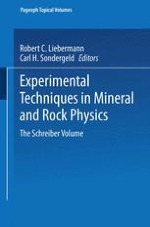1994 | OriginalPaper | Chapter
Controls on Sonic Velocity in Carbonates
Authors : Flavio S. Anselmetti, Gregor P. Eberli
Published in: Experimental Techniques in Mineral and Rock Physics
Publisher: Birkhäuser Basel
Included in: Professional Book Archive
Activate our intelligent search to find suitable subject content or patents.
Select sections of text to find matching patents with Artificial Intelligence. powered by
Select sections of text to find additional relevant content using AI-assisted search. powered by
Compressional and shear-wave velocities (V p and V s ) of 210 minicores of carbonates from different areas and ages were measured under variable confining and pore-fluid pressures. The lithologies of the samples range from unconsolidated carbonate mud to completely lithified limestones. The velocity measurements enable us to relate velocity variations in carbonates to factors such as mineralogy, porosity, pore types and density and to quantify the velocity effects of compaction and other diagenetic alterations.Pure carbonate rocks show, unlike siliciclastic or shaly sediments, little direct correlation between acoustic properties (V p and V s ) with age or burial depth of the sediment so that velocity inversions with increasing depth are common. Rather, sonic velocity in carbonates is controlled by the combined effect of depositional lithology and several post-depositional processes, such as cementation or dissolution, which results in fabrics specific to carbonates. These diagenetic fabrics can be directly correlated to the sonic velocity of the rocks.At 8 MPa effective pressure V p ranges from 1700 to 6500 m/s, and V s ranges from 800 to 3400 m/s. This range is mainly caused by variations in the amount and type of porosity and not by variations in mineralogy. In general, the measured velocities show a positive correlation with density and an inverse correlation with porosity, but departures from the general trends of correlation can be as high as 2500 m/s. These deviations can be explained by the occurrence of different pore types that form during specific diagenetic phases. Our data set further suggests that commonly used correlations like “Gardner’s Law” (V p -density) or the “time-average-equation” (V p -porosity) should be significantly modified towards higher velocities before being applied to carbonates.The velocity measurements of unconsolidated carbonate mud at different stages of experimental compaction show that the velocity increase due to compaction is lower than the observed velocity increase at decreasing porosities in natural rocks. This discrepancy shows that diagenetic changes that accompany compaction influence velocity more than solely compaction at increasing overburden pressure.The susceptibility of carbonates to diagenetic changes, that occur far more quickly than compaction, causes a special velocity distribution in carbonates and complicates velocity estimations. By assigning characteristic velocity patterns to the observed diagenetic processes, we are able to link sonic velocity to the diagenetic stage of the rock.
